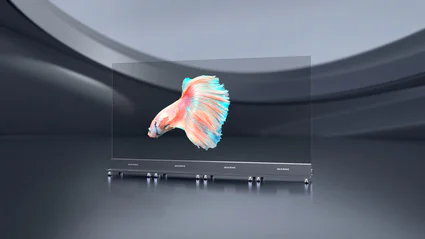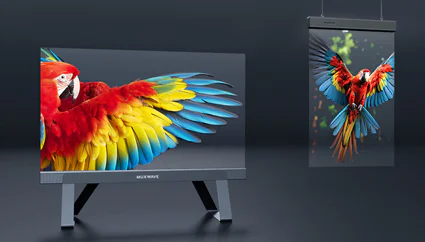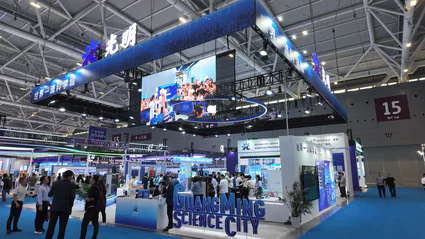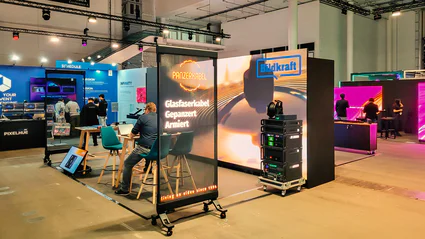Principaux enseignements
- Il est possible de fabriquer des modules LED d'une épaisseur de ≤2 mm, mais il faut considérer la rigidité mécanique, la diffusion de la chaleur et l'efficacité du pilote comme un système unique.
- La recette la plus sûre combine des composants COB/IMD ou SMD à pas fin, une diffusion de chaleur en graphite ou en cuivre, des circuits d'attaque à haute teneur enη et des adhésifs thermoconducteurs liés à un substrat rigide (souvent en verre ou en métal).
- La luminosité réelle provient de la gestion du plafond thermique (contenu APL, gradation diurne, plafonds par zone), et non d'une valeur nit en laboratoire.
- Validez avec des calculs de densité de puissance, des vérifications thermiques par différences finies et un pipeline d'étalonnage prêt pour l'appareil photo (rafraîchissement, gamma, point blanc) avant d'engager l'outillage.
Ce que signifie réellement “≤2 mm
“L”"épaisseur" est la hauteur de l'empilement de toutes les couches au-dessus de la surface de montage : DEL/encapsulation + masque/optique + couche de finition protectrice + adhésif + FPC/PCB. Les exclusions (crochets de montage, connecteurs) doivent être spécifiées explicitement dans les dessins. Les empilements typiques visent à :
- Émetteur + encapsulation : 0,35-0,7 mm (COB/IMD ou SMD1515/1010)
- FPC ou PCB ultra-mince : 0,10-0,30 mm (polyimide avec cuivre)
- Adhésif thermique/structurel : 0,10-0,25 mm (comblement des lacunes, 1-3 W/m-K)
- Masque/couche optique/couche supérieure : 0,05-0,20 mm (mat, micro-baffle)
- Objectif total : 1,6-1,9 mm nominal pour laisser de la tolérance et se protéger contre les pics locaux.
Règle d'or : si la pile optique devient plus fine, la rigidité et la diffusion de la chaleur doivent augmenter pour limiter les déformations et les points chauds.
Options d'architecture pour les modules ultraminces
COB/IMD sur FPC (flex PCB)
- Pour : hauteur z la plus faible ; excellent remplissage des pixels ; moins de joints de soudure ; robustesse au toucher.
- Cons : la chaleur doit se déplacer latéralement ; le FPC seul est trop conforme - il faut un support en verre/métal.
SMD à pas fin sur PCB ultra-mince
- Pour : écosystème mature ; bacs remplaçables.
- Cons : Hauteur z légèrement plus élevée ; plus d'articulations ; nécessite une conception minutieuse du masque pour éviter la formation d'étincelles.
Film LED Écran
- Pour : naturel ≤2 mm se construit ; s'adapte aux courbes ; se stratifie sur le verre (le verre devient un dissipateur thermique).
- Cons : pas plus grossier ; remplissage plus faible ; règles de contenu différentes (macro-imagerie ; blocs à fort contraste).
Substrats / supports
- Verre trempé (1-2 mm) : Excellente planéité, clarté optique, résistance aux rayures ; forte diffusion de la chaleur si elle est collée avec un adhésif à haute teneur enη.
- Tôle d'aluminium/magnésium (0,5-1,0 mm) : léger, bonne κ (conductivité), facile à former ; nécessite une isolation.
- Feuille de graphite (PGS 0,05-0,1 mm) : superbe diffusion de la chaleur dans le plan ; associer au verre/métal pour la rigidité.
- Peaux en CFRP (fibre de carbone) : ultra rigides et minces ; la conductivité dépend de la composition ; attention à la compatibilité électromagnétique.
Densité de puissance, pas seulement des bits
La contrainte dominante pour les modules ≤2 mm est l'augmentation de la température (ΔT) au niveau des groupes de pixels les plus chauds.
Objectifs
- Maintenir les températures de jonction ≤ 85-95°C pour une longue durée de vie (exact selon le fournisseur de LED).
- En intérieur, à l'air libre, prévoyez ΔT ≤ 25-30°C à votre APL le plus défavorable.
- Dans les constructions en verre stratifié, exploitez la masse de verre comme un puits -ΔT peut chuter de 20-40%.
Implications
- Un module qui passe à 1000 cd/m² sur un banc peut s'étrangler une fois collé à un mur thermiquement isolant. Ingénieur pour la condition limite finale.
Des astuces thermiques qui fonctionnent vraiment
S'étaler d'abord, puis couler
- Ajouter du graphite PGS sous les émetteurs pour répartir la chaleur latéralement avant qu'elle ne rencontre l'air.
- Coller au verre ou à l'aluminium mince avec un adhésif de 1-3 W/m-K ; éviter les rubans moussés avec κ < 0,5.
Utiliser l'hôte comme dissipateur thermique
- Sur verre, Le feuilletage sur toute la surface (pas de vide d'air) transforme la vitre en un puits passif.
- Sur les façades métalliques, un diélectrique fin + un support en aluminium forment un chemin de chaleur important.
Plafonds de luminosité par mode
- Définir les profils jour / crépuscule / nuit avec des plafonds par zone ; les vitrines ont rarement besoin de la valeur maximale du laboratoire.
- Appliquer les limites de l'APL dans le CMS (par exemple, limiter le plein blanc à 85-90%).
Efficacité et analyse du conducteur
- Choisissez des pilotes à courant constant élevé et réglez le rapport de balayage pour équilibrer l'ondulation, le scintillement et la chaleur.
- Le rafraîchissement ≥3840 Hz réduit l'effet de bande à des cycles d'utilisation plus faibles, ce qui vous permet d'exécuter des programmes d'entretien et de maintenance. refroidisseur sans artefacts de caméra.
Une pile optique qui aide à la réduction des émissions de gaz à effet de serre
- Préférez les masques mats à micro-baffles pour réduire l'éblouissement sans avoir besoin d'une force brute de nits.
- Verre de couverture à faible teneur en fer (s'il est utilisé) permet de conserver une couleur neutre ; éviter les diffuseurs épais qui retiennent la chaleur.
Un contenu qui coopère
- Utilisez des images macro, des champs de couleurs unies, des dégradés légers ; évitez les arrière-plans blancs à haut niveau de pollution.
- Pour les transparents/films, les palettes sombres la nuit réduisent l'APL et mettent l'accent sur la transparence.
Mécanique
Les modules ultrafins sont intrinsèquement flexibles - parfaits jusqu'à ce que les coutures apparaissent. Prévoir pour :
- Rigidité en flexion : L'EI augmente avec l'épaisseur³ ; si vous réduisez l'épaisseur de moitié, vous perdez 8 fois la rigidité. A contrer avec des supports rigides (verre/métal) et des portées courtes.
- Inadéquation CTE : FPC ↔ verre/métal. Choisir des adhésifs élastomères qui tolèrent le cisaillement ; utiliser des trous oblongs plutôt que des broches dures.
- Spécification de planéité ≤ 0,3-0,5 mm sur l'ensemble du module - au-delà, les coutures capturent les reflets spéculaires.
- Service avant : Les aimants et les micro-latches minimisent l'épaisseur du matériel ; définissez la force d'arrachement pour ne pas décoller l'adhésif.
Finitions optiques à ≤2 mm
- Encapsulation : silicone ou époxy-silicone avec un faible voile, une stabilité aux UV et une dureté de crayon ≥ 2H pour les installations publiques.
- Masque : des parois cellulaires très fines (noir peu brillant) pour masquer les micro-non-uniformités ; éviter les textures périodiques qui peuvent introduire un effet de moiré.
- Couches de finition anti-salissures : Les vernis fluoropolymères facilitent le nettoyage sans ajouter d'épaisseur.
- Options de transparence : pour les films et les constructions transparentes, gérer la surface ouverte en fonction de la résolution perçue ; aligner le contenu en conséquence.
Considérations électriques et de contrôle
- Topologie de l'alimentation : distribuer à basse tension / haut courant avec précaution - utiliser des coulées de cuivre plus larges sur le FPC, et garder les connecteurs hors de portée de vue.
- CEM : les empilements ultra-minces rayonnent plus facilement ; veillez à ce que les chemins de retour soient étroits, ajoutez des films de blindage si nécessaire et validez les émissions rayonnées/conduites à un stade précoce.
- Étalonnage : fournir des LUTs en usine et sur site pour le jour et la nuit ; verrouiller le gamma à ~2,2 (détail) ou 2,4 (halls sombres).
- Contrôle : température NTC embarquée les capteurs permettent à la CMS d'appliquer des plafonds avant de procéder à l'étranglement.
Fiabilité et sécurité pour une épaisseur minimale
- Durée de vie des LED : maintenir les températures de jonction à un niveau bas ; éviter les cycles thermiques > 25°C en alternance jour/nuit.
- Ingress : Les piles de ≤2 mm sont généralement IP30-IP41 ; pour des agressions plus importantes, utiliser des revêtements conformes ou des couvercles avec joints.
- Impact : préciser Niveau IK s'ils sont accessibles au public, il est prudent d'utiliser des supports en verre trempé.
- Normes : plan pour IEC/UL 62368-1, EMC (EN 55032/35), RoHS/REACH.
- Nettoyage : Nettoyants sans alcool ; microfibres uniquement ; publication d'une carte d'entretien.
Stratégie de gradation durable
- Associer les modules à des capteurs de lumière du jour et à des fenêtres de lissage (3-5 s) pour éviter les “respirations”.”
- Utilisez des palettes de nuit (arrière-plans plus sombres, blancs plus chauds) pour réduire la puissance et l'éblouissement.
- Pour les constructions transparentes/films, il faut maintenir un contraste élevé sans APL élevé ; les acheteurs doivent voir à travers, et non pas regarder fixement dans les reflets.
Liste de contrôle pour le prototypage et la validation
Mécanique
☐ Planéité ≤ 0,5 mm après laminage complet
☐ Essais d'adhésion par pelage/cisaillement sur le substrat final
☐ Baisse/impact en cas de contact avec le public
Thermique
☐ Capture IR à la teneur maximale ; cartes ΔT archivées
Estimation de la jonction par rapport aux spécifications pour 3 températures ambiantes (15/25/35°C)
☐ Alimentation NTC dans CMS avec logique d'alarme/de capitalisation
Optique
☐ Étalonnage gamma/point blanc (ligne de base D65)
Tests de la caméra à 30/60 fps, obturateurs communs
☐ Évaluation du moiré sur des motifs fins
Électricité/CEM
☐ Scanners effectués/radiés avant la certification
☐ Plan de traitement des décharges électrostatiques (ESD) ; vérification des chemins de mise à la terre
Recommander la lecture
1. Écrans LED transparents et écrans LED traditionnels
2.Comment les écrans LED transparents révolutionnent les vitrines de magasins
3.Les 10 meilleurs écrans LED incurvés pour les salons et expositions



